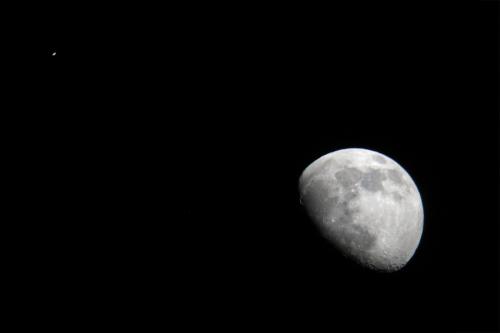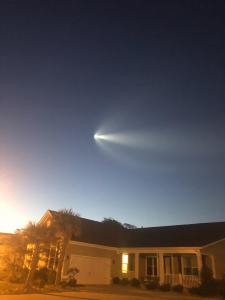Celebration of Space - January 12, 2024

Saturn and the waxing gibbous Moon in conjunction at Frosty Drew Observatory. Credit: Frosty Drew Astronomy Team member, Scott MacNeill.
This coming Sunday, January 14, 2024, step outside during late twilight (around 6:00 pm), and catch a stunning view of Saturn and the super thin 16% waxing crescent Moon in conjunction. The view will happen over the SW horizon, where the Moon will sit about 6.5° east of Saturn. While observing the celestial dance take note that you will be able to see the shadow side of the Moon alongside the bright crescent. This phenomenon is called Earthshine, and happens when bright sunlight reflects off of Earth and illuminates the nighttime regions of the Moon. The view should be easy from most locations with a clear view of the SW sky, though darker sky conditions will be much better.
If you happen to miss out on the conjunction of Saturn and the crescent Moon, second chances rock, as there will be another conjunction on Thursday, January 18th. This time the conjunction will involve the waxing gibbous Moon and Jupiter, and the view will be much easier to see. Step outside anywhere you have a clear view of the sky, even in the city, about an hour after sunset, and look overhead while facing south. The bright 59% waxing gibbous Moon will be very visible, and just below and to the right, about 2.25° away, will be Jupiter. Let us know if you see either of these conjunctions.
This coming Wednesday, January 17, 2024 at 5:11 pm EST, the SpaceX Falcon 9 launch vehicle will depart from Kennedy Space Center, FL The launch is the Axiom Mission 3, which is a commercial launch, and will carry the SpaceX Dragon module with passengers to the ISS. If the launch date and time sticks, we may be able to see the launch low over the SE – E horizon. If the sky is clear, set out to a location with a clear view of the SE→ E horizon, and be there for 5:00 pm. Look within 20° of the SE horizon to see if you can spot the spacecraft. The launch vehicle will appear like a fast moving star heading towards the E. Please note that visibility maps are not usually publicized by SpaceX and our estimate is based on a rough calculation. So, you may not see it at all, but sunset launches are very much worth viewing as the launch vehicle may be in sunlight, which will show a lot more detail than a nighttime launch. So we think it is worth a try. Let us know if you happen to see it.
Now that the International Space Station (ISS) and China’s Tiangong station have returned to the evening sky over the US, fantastic pass sightings are scheduled for each night. Catching a view of the ISS or Tiangong is quite an inspirational experience, as we are observing humanity’s only space based residences orbiting overhead. Unlike most satellites, the stations are very bright and easily visible. Here are a list of notable passes for this weekend and coming week of both stations over our region:
ISS:
Sat, Jan 13 at 6:11 pm, starting in the S, rising to 16°, heading towards the SSE, and into orbital sunset
Sun, Jan 14 at 6:58 pm, starting in the SW, rising to 25°, and into orbital sunset
Mon, Jan 15 at 6:10 pm, starting in the SW, rising to 48°, heading towards the ESE, and into orbital sunset
Tue, Jan 16 at 5:21 pm, starting in the SSW, rising to 27°, heading towards the ENE
Tue, Jan 16 at 6:58 pm, starting in the W, rising to 29°, and into orbital sunset
Wed, Jan 17 at 6:09 pm, starting in the WSW, rising to 61°, heading towards the NE, and into orbital sunset ← Awesome pass!
Thu, Jan 18 at 5:20 pm, starting in the SW, rising to 78°, heading towards the ENE ← Awesome pass!
Tiangong:
Fri, Jan 12 at 5:08 pm, starting in the SW, rising to 32°, heading towards the E
Fri, Jan 12 at 6:44 pm, starting in the W, rising to 35°, and into orbital sunset
Sat, Jan 13 at 5:43 pm, starting in the WSW, rising to 69°, heading towards the E, and into orbital sunset ← Awesome pass!
Sun, Jan 14 at 6:18 pm, starting in the W, rising to 86°, and into orbital sunset ← Awesome pass!
Mon, Jan 15 at 5:16 pm, starting in the W, rising to 85°, heading towards the E ← Awesome pass!
Tue, Jan 16 at 5:52 pm, starting in the W, rising to 87°, heading towards the E, and into orbital sunset ← Awesome pass!
Wed, Jan 17 at 6:27 pm, starting in the W, rising to 63°, and into orbital sunset ← Awesome pass!
Thu, Jan 18 at 5:25 pm, starting in the W, rising to 83°, heading towards the E ← Awesome pass!
That is a fantastic week of awesome station passes, especially Thursday, January 18th, where you will have the ISS and Tiangong back to back. To see these stations pass over all you need is a clear view of the sky. Both satellites are bright enough to be seen even over heavily light polluted urban regions. Note that these pass times are for Southern New England residents, but are applicable for all Northeast residents. For daily pass times of brighter satellites over these regions, visit the Frosty Drew Daily Satellite Pass Prediction Utility.
- Author:
- Scott MacNeill
- Entry Date:
- Jan 12, 2024
- Published Under:
- Scott MacNeill's Columns



